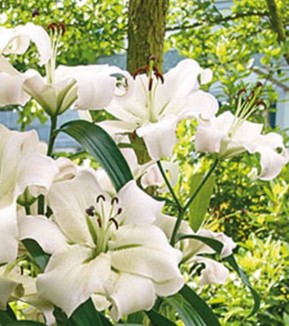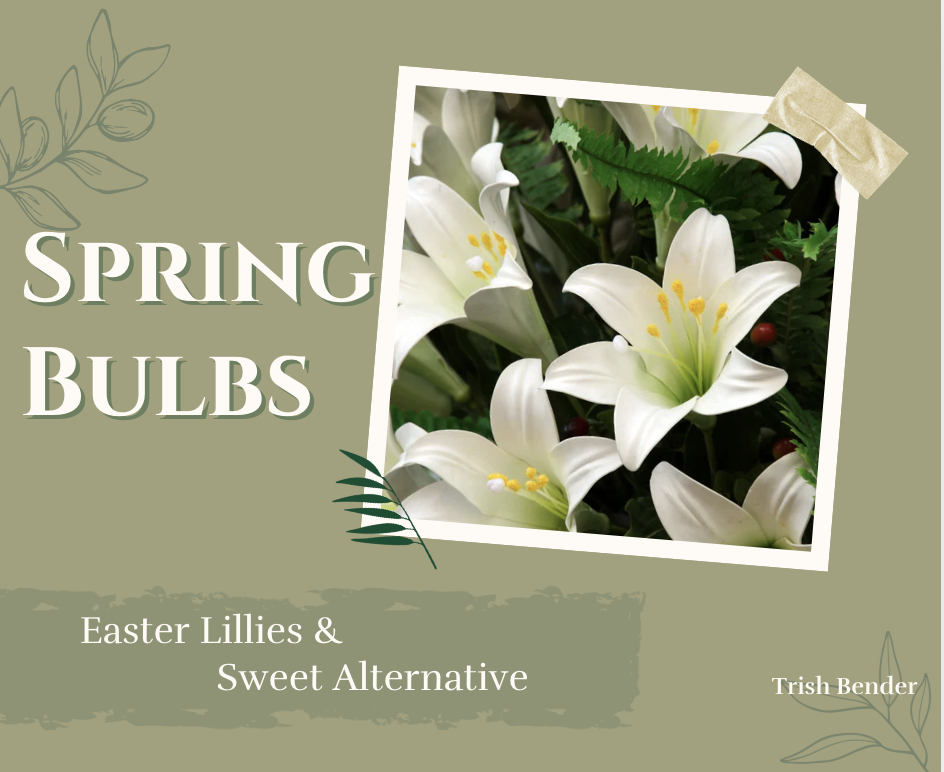Easter Lilies and Alternatives for Other Growing Zones
Easter lilies (Lilium longiflorum) are a hallmark of spring, as their white flowers symbolize purity, renewal, and hope. With their trumpet-shaped white blooms and sweet fragrance, they are a favorite choice for Easter celebrations and seasonal décor. However, while Easter lilies thrive in USDA hardiness zones 7-9, they may not be suitable for all climates. Fortunately, there are plenty of beautiful alternatives for those in colder or warmer regions.
Like Poinsettias, Chrysanthemums, and Amaryllis, Easter lilies are typically sold as blooming potted plants. Originally from Japan and Taiwan, commercial lilies began their trek to America via Bermuda in the late 1800s. Today, 95% of Easter lilies are commercially grown in Northern California and Southern Oregon nurseries. Approximately 12 million are shipped each year. Like many seasonally potted flowers, they are forced to bloom in time for their respective holiday and then discarded afterwards. However, many savvy gardeners simply cut off the spent blooms and plant them in their own gardens to regrow the following year. So much in fact, that many a church yard across the country becomes a sea of white blooms just in time for Easter services.
While they do best in Zones 7-9, they can be found all the way up to zone 5 in protected areas.
Growing Lilium longiflorum requires little effort, provided the bulbs are kept free of mice and voles, and the leaves guarded from the occasional hungry rabbit or deer who nibble both leaf and flower. It should also be noted that most lilies, including Lilium longiflorum are highly toxic to cats. Full to partial sun, well-drained slightly acidic soil, consistent watering and frost free temps. Where lilies encounter light frosts, a heavy mulch can do wonders. If you live in a colder region (below zone 7), Easter lilies may not survive the winter unless they are dug up and stored or treated as annuals.
If white is not your favorite choice, Lilium longiflorum has a delightful pink cousin with deep pink-mahogany centers.
For our mid-Western and far Northern gardeners in zones 3-6, consider these hardy alternatives:
Madonna Lily (Lilium candidum) Native to the Balkans, this highly adaptable lily has become a popular, even naturalized specimen, all across Europe and North Africa, as well as the United States and Mexico. Having a taller upright stem and smaller flowers, its fragrant blossoms are sure to please. It thrives in zones 4-8, prefers more well-drained soil and full sun compared to Easter lilies.

Asiatic Lilies (Lilium spp.) Hardy in zones 3-8, these lilies come in a variety of colors and are much easier to grow than Easter lilies, accepting a large range of soil conditions and watering needs. Although most are much less fragrant than the Lilium longiflorum, they make excellent cut flowers and can create a delightful backdrop for summer gardens. Almost every bulb nursery has their own white hybrids, although it is hard to beat the Giant Orienpet “Pretty Woman” from K. Van Bourgondien bulb company. Towering to 6’ tall with 8” trumpet blossoms with a delightful aroma, these hybrids can grow multiple blooms from a single stem.

For our tropical gardeners in zones 9-11, consider these heat-tolerant lily beauties:
Rain Lilies (Zephyranthes spp.)
Although much smaller than Easter lilies, these dainty lilies thrive in zones 7-11 and come in a wide variety of colors. Adding a perfect punch to the front of any garden bed, they tend to bloom right after a rain and put most of their energy into blooms not big strappy leaves. In fact, when not in bloom they often blend into the border grasses and can be easily mistaken for Liriope or Carax.

Crinum Lilies (Crinum spp.)
From pure white to creamy white-yellow, or white with a deep pink tinge, not much beats crinum lilies for zones 8-11. With large showy flowers on leafless stems, there are hundreds of varieties and all flourish in full sun and varying degrees of moist soil from well-drained to swampy.
There is a giant variety called Crinum asiaticum found in many southern gardens that can almost reach the rooftop, and readily multiplies in a nice damp spot.
Again, plant with caution as this variety is also called poison lilies for their toxicity.

White Spider Lily (Hymenocallis littoralis)
Perhaps the most aquatic species of lily is the spider lily, often grown along pond edges or within the marginal bog zone. Producing striking white blooms with slim petals that give it its name, the delicate fragrance has strong notes of vanilla. Thrives in zones 8-11.

Whether you love Easter lilies for their symbolism or their beauty, there are plenty of options to suit your climate. If you live in an area where Easter lilies aren’t ideal, consider planting a similar-looking or similarly fragrant flower that thrives in your growing zone. By choosing the right plants, you can enjoy the spirit of Easter and the joy of spring to summer blooms no matter where you garden.
Note - all photo credits sourced from Wikipedia or the USDA Plant database.

 Member Login
Member Login







